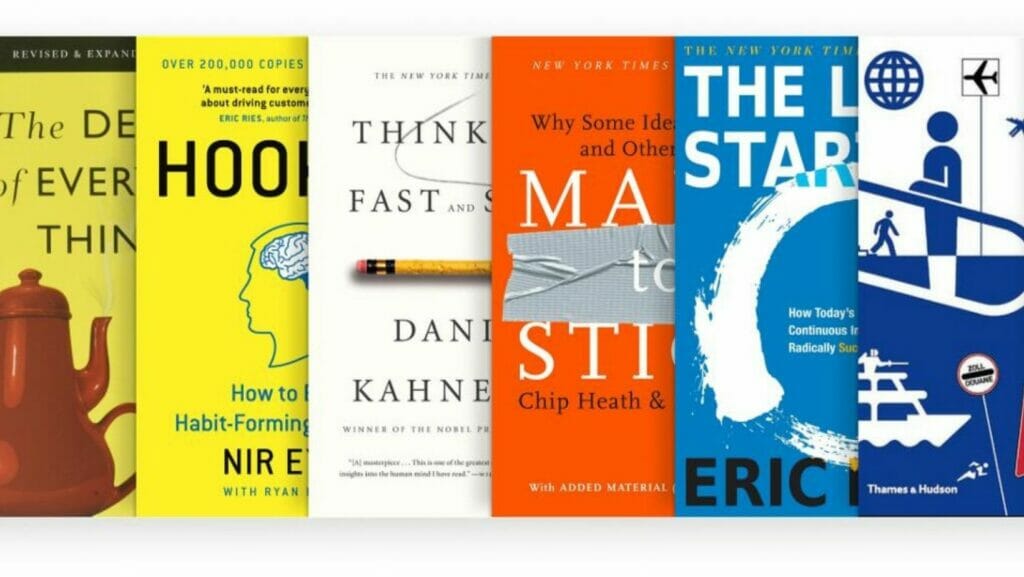Some fans of action and practice may say that reading books is dull. It wastes their time. The ideas and reminiscences of other people can’t teach them anything new today, as the world of design is changing fast.
Still, it’s vital to remember that design is about human psychology, so it’s ageless. There is nothing wiser than investing time and effort into understanding how people have approached design from times immemorial.
More than that, what can be better than getting on a cozy couch with some snacks and an exciting design story? That’s a winning formula for a rainy day!
And the final argument – when recruiters hire UX designers, they often ask about the books they read and inquire about which books inspire them. So, yes, books really matter in this profession, and you can improve the HR’s impression by naming a few golden-standard design works written by design gurus. Here’s a list of the hottest recommended works revealing the secrets of design art.
UI Is Communication (Everett McKay, 2013)
As McKay explained it, the book is intended to help UX designers cut through the noise and abundance of information in the profession, focusing on clear, actionable work plans for product design from zero. These designs need to be intuitive and focused on the user to be successful. In this way, effective communication can be achieved, contributing to product success.
The key point of McKay is that a design process will be effective if you do it with productive communication in mind. He covers interaction design and visual design essentials in simple terms, giving even UX beginners the upper hand in design practice. Besides, many readers praise McKay’s practical breakdown of the communication-driven design process.
Hooked (Nir Eyal, 2014)
A global best-seller of Eyal is not only about how to make your designs likable. It’s about how to get people addicted to your products, eager to change their habits and preferences to use your offering daily. It sounds pretty unrealistic, but it really works if the benefit of the offered product exceeds people’s reluctance to change. We’ve already seen that with Apple devices, social media, SaaS, and P2E games, actually.
What Eyal is into is the simple and genius algorithm of hooking people to your design. The author proposes a very easy gamification model that includes:
- a trigger
- some action
- an appealing reward
- investment from the user.
Once the user gets attracted to the app or product you’re offering and does the first step (a sign-up, avatar addition, registration), they enter the trigger-action-reward-investment loop that promises gains and pleasures from its use. The easy, humorous style and super valuable content of this book are sure to make your day.
Creative Selection: Inside Apple’s Design Process (Ken Kocienda, 2018)
Apple has been a design wonder for many years and continues to exceed user expectations with every new issued model. So, what makes the simple yet elegant solutions, marketed to unbelievable heights by Steve Jobs, so special? Ken Kocienda knows this for sure, as he’s been with the company for 15 years, working on the engineering and design tasks for iPhone.
The core idea you can feel throughout this book is that only an exclusive focus on the product can bring you to the point where users will really admire it. Fans of Apple’s history will also find many exciting details about the 2nd era of Steve Jobs in the company. So, this reading will be an exquisite experience for many of you, whether you like iPhones or not.
The Design of Everyday Things (Don Norman, 2015)
The majority of simple, everyday things people use are designed with simplicity and usability in mind. It’s hard to imagine an oven or a kettle that doesn’t offer intuitive pointers on how you can turn it on or off. It’s next to unbelievable to see a door that has an intricate sliding mechanism that a person needs to guess. So, that’s the key idea of Don Norman in his 2015 masterpiece – the things we see around us are very simple and well-designed with years of human experience in mind, and digital design can learn those hard-earned lessons.
As Norman manages to show, a usable design that all people will love is achievable if you follow a few simple rules. First, everything should be visible in the design – controls, menu, features, and user actions should cause no pain and require no guesswork. Second, you can take advantage of natural relationships coupling function and control in UX, using constraints wisely to streamline user actions. In this way, users get a non-intrusive yet informative guideline for using your resource and completing the intended activities.
Don’t Make Me Think, Revisited (Steve Krug, 2013)
As the book’s name suggests, its author focuses on the common sense approach to usability, which is usually very simple. Krug goes through the common mistakes designers make when they stretch themselves to deliver exceptional products to users. According to Krug, people use the Internet for scanning, not careful reading. So, the products that stick with the users should be simple and eloquent. His method is that of billboard design – an all-in-one attention-grabber containing all vital features and benefits of the product.
Besides sparkling humor and tons of valuable real-life cases, the author gives much helpful information for design-related decisions. The book contains:
- a chapter on content writing for winning designs
- proper design of menu and breadcrumbs,
- a discussion on design arguments and tensions between different schools
- an emphasis on the overwhelming importance of usability testing.
The Revisited version has also incorporated a discussion of newer trends in product design, such as mobile optimization, accessibility, and holistic design approaches.
The Mom Test (Rob Fitzpatrick, 2016)
This book is another gem in every product designer’s collection. It teaches you to think critically about your own subjectivity and bias towards your brainchild. The author shows how a tediously researched and created design becomes a dear “baby” to the design team, which refuses to see its flaws and seeks any possible reason to leave things as they are. So, to avoid this psychological test, you need to take “the mom test” proposed by Fitzpatrick. It’s really a witty way of distancing yourself from your product and approaching it objectively.



















